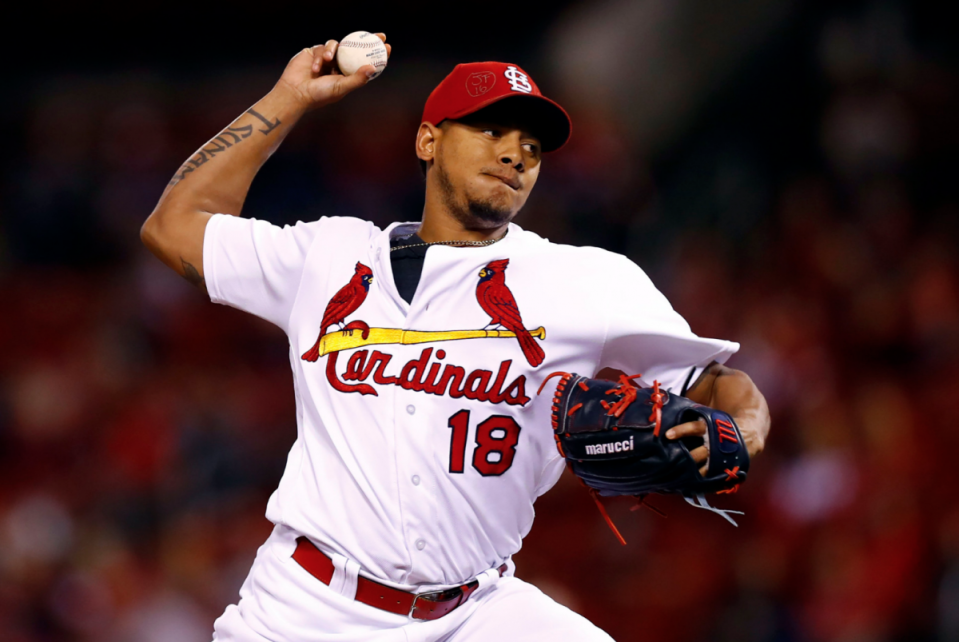Pitchers to trust or trade based off early strikeout numbers

It’s still very early — but not for everything. When it comes to strikeout rates, it’s way later than you think.
Strikeout rates for pitchers stabilize at 70 batters faced, a figure many have passed. That means that at least half of the current rate can be attributed to skill (the rest is random). This is the equivalent of 1,320 batters faced for a pitcher’s home-run rate to stabilize. And the strikeout rates of most starters right now are as meaningful as batting average would be for a hitter after 910 at bats or his line-drive rates after 600 balls in play, according to According to Russell Carleton as cited at Fangraphs.
So we should treat these strikeout rates right now very seriously. The best approach is predicting that pitchers land about halfway between their current rate and their career averages.
Let’s look first at the pitchers who are greatly exceeding their strikeout projections.
[Sign up for a Yahoo Daily Fantasy Baseball contest today]
Carlos Martinez (Cardinals) has a rate of 30% vs. his prior career average of 22.7%. He’s always had elite velocity and a proven ability to keep the ball on the ground and in the park. But now the ground balls are way down — 40.9% vs. about 55% previously in his career. Is Martinez, who is throwing harder than in the last two years at 95.9 MPH on average, a fundamentally different pitcher? Note it takes 70 balls in play for ground-ball or fly-ball rates to stabilize. Martinez has less than 50. So table the ground-ball rate for now but bet on the Ks. Splitting the difference at about a 4% projectable bump in Ks, you can give Martinez about 30-to-40 more Ks than were expected in March — a huge bump in value.
Sean Manaea (A’s) is up to 28.2% from 20.9% in his rookie year. The ERA has not followed in his case but there’s a decent chance Manaea, who was in the conversation for being the top overall pick in his draft class prior to an injury, is an elite strikeout arm. Manaea’s swinging strike rate was good last year (11.8%) but is top shelf now (15.6%).
Tyler Skaggs (Angels) has a more modest but still significant bump to 25% from 20%. This would make him projected to be average in strikeout rate (call it 22.5%). But his swinging strikes are up more than 50% to 12.6%. And while Skaggs was under 7.0 K/9 the last time he threw over 100 innings (2014), he K’ed over a batter per inning last year (50 frames). So consider betting the full current rate, making Skaggs rosterable in all formats.
Some pitchers are on the wrong side of this data, meaning far less Ks than projected and thus giving us far more reasons to worry:
Patrick Corbin (Diamondbacks) is down from to 9.1% from 19.6%. The theory for Corbin off the great spring was that a return to health would make him a solid albeit unspectacular mixed-league arm. But that is not materializing. Corbin doesn’t seem to have lost velocity (92.3 is on his high side, though MPH may be up about 1 MPH on average due to now uniform ballpark technology). But he’s apparently lost movement as his swinging strike rate is an unplayable 6.1%. You can drop Corbin in all formats given he’s two years removed from surgery.
Gerrit Cole (Pirates) has dropped to 14.7% from 22.4%. I’ve never been a Cole fan but so many others are also down on him now so he can appear to be a value. Appearances can be deceiving. Cole has never K’ed in line with his velocity and has been a big plus in the category once — 2015. I think his projection going forward in 2017 is to be merely average in strikeouts. So sell if you can.
Kevin Gausman (Orioles) has declined to 15.1% from 21.5%. I figured the averages would be a problem potentially for Gausman. But he’s all hard stuff (fastball and slider) and his split-finger has not developed into a put-away pitch. In fact, it’s being crushed even though he throws it less than 10% of the time.
Cole Hamels (Rangers) is down to 14.7% from 23.3%. Hamels is at an age where you have to worry about a decline in stuff. His velocity is what we’re expecting but, again, movement appears to be the issue. He’s generating misses on swings at about half his historic rate. The smart play here is to bet a subpar K rate and try to trade him for his March price given his averages are okay. Plus your leaguemates may be thinking incorrectly that these K samples we now have are meaningless — but you know better.



